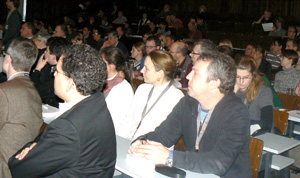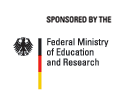Report NGFN-Meeting Neuherberg 2008
The Annual Meeting of the National Genome Research Network (NGFN) took place this year for the seventh time and was a full success! An overwhelming number of roughly 470 participants had registered for this conference from December 12th – 13th 2008.
The meeting was held at the Helmholtz Zentrum in Munich / Neuherberg (HMGU), and also marked the Kick-off Meeting for NGFN-Plus and NGFN-Transfer within the novel “Program of Medical Genome Research” by the German Federal Ministry of Education and Research (BMBF).
The advent to the meeting was marked by two well-attended workshops on Thursday, December 11th, giving profound insights into the world of BMBF-funded medical genome research within the NGFN:
The first workshop, the NGFN “Next Generation Sequencing Program”, was directed by Dr. Richard Reinhardt from the Max-Planck-Institute for Molecular Genetics in Berlin-Dahlem. The goal of this program is the sequencing of whole genomes in a reasonable timeframe at adequate costs. Various speakers from academia as well as collaborators from industry were presenting their vast datasets obtained in the Next Generation Sequencing program. These included the highly relevant quality management system of this program as well as prices for and capacities of the available technologies. The Next Generation Sequencing program so far has been a great success by being cheaper and faster than expected.
In the second workshop, “The NGFN Program for Complex Phenotypes” under the aegis of Prof. Dr. Stefan Schreiber, Director of the Institute of Clinical Molecular Biology (IKMB) Kiel, impressive results in the realm of the NGFN-funded Genome-Wide Association Studies (GWAS) were presented.
The data showed that the GWAS program, funded by the NGFN and established in October 2006 by the NGFN project committee, had been extremely useful in revealing the complex genetics involved in diseases of high socio-economical relevance, like cardiovascular, neurological, and inflammatory diseases. The success of this project was mainly due to the selected patient and control cohorts from the five disease-orientated networks of NGFN-2 and from the KORA-gen and PopGen biobanks, which were included in a collaborative genome-wide association study.
On Friday, the official meeting started by welcoming remarks of Prof. Dr. Günther Wess, Scientific Director of the Helmholtz Zentrum, and Dr. Elmar Nimmesgern, representative of the Federal Ministry of Education and Research (BMBF), Germany. They pointed out the immense success the funding of the NGFN had already been, thereby laying the foundations for the continuous support of medical genome research. On behalf of the Project Committee, Prof. Dr. Martin Hrabé de Angelis, HMGU, welcomed the numerous attendees and officially opened the meeting.
Symposium 1, Genomics of Common Disease, was influenced by the Genome-Wide Association studies and started with a presentation of results of the QTSCD consortium by Dr. Arne Pfeufer, HMGU Munich. The QT interval is a measure of cardiac re-polarization, and predisposes to Sudden Cardiac Death. His results provided new insights into myocardial electrophysiology.
The wide-spanning area of the GWAS studies was further demonstrated by results regarding vulnerability to alcohol dependence, micro-deletions associated with schizophrenia, loci associated with neuronal body weight regulation, and the association of NF-?B and IL-23 pathways with psoriasis. The symposium was concluded by the presentation of results from the first Genome-Wide Association Study on IgE levels by Dr. Thomas Illig, HMGU Munich, revealing variations within the gene encoding the alpha chain of the high affinity receptor for IgE (FCER1A) as a susceptibility locus.
Dr. Ralf Herwig, MPI for Molecular Genetics, Berlin, was the keynote speaker for Symposium II, Systems Biology. He showed the Consensus Path Database which contains information on metabolic pathways, signal-transduction pathways and gene regulatory networks in human beings integrated in a common schema. He demonstrated the use of algorithms and the linkage with clinical data to find differential expression patterns in prostate cancer cell lines.
The key lecture for the Genome Regulation Symposium III was given by Prof. Dr. Martin Vingron from the MPI for Molecular Genetics in Berlin. He pointed out that there is abundance in predicted Transcription Factor Binding Sites after a matrix scan, and that the problem was to find the functional ones. This problem is consecutively solved by biophysical models for single sites. The binding affinity is deduced from binding energy calculations, because different transcription factors have different binding affinities.
In Symposium IV, Animal, Cellular & Tissue Models, Dr. Jan Rozman (HMGU, Munich) gave a presentation about the German Mouse Clinic (GMC). The GMC was established for the systemic phenotyping of mutant mouse lines to model genetic human diseases. Strikingly, from 84 mutant mouse lines analyzed until May 2008, 95% showed new or additional phenotypes. 320 key parameters in 14 different disease areas had been screened, and most of the mutant lines are from laboratories of members of the NGFN, demonstrating the success of the NGFN-funding.
Prof. Dr. Cornelia van Duijn, Erasmus University, Rotterdam, the Netherlands, was the keynote speaker for Symposium V, Genomic / Environmental Interaction. With her very descriptive examples about probabilities, i.e. the odds for a woman to become pope or a man to end up in prison, she gave a vivid presentation about risk prediction in the GWAS studies.
Dr. Hadi Al-Hasani, German Institute for Human Nutrition, Nuthetal, presented in the same symposium his results concerning TBC1D1 obtained in mice, which might play a role in a novel pathway that regulates energy homeostasis in both mice and humans. Mutation of Tbc1d1 leads to an enhanced uptake of fatty acids in sceletal muscle cells and at the same time to an increased fatty-acid oxidation in mice.

Lively discussion of results in the Auditorium of the HMGU
The Evening lecture on Friday, was given by Prof. Dr. Matthias Mann, MPI of Biochemistry, Martinsried, who presented outstanding data regarding High Resolution Proteomics in Functional Genomics. He demonstrated that yeast is an excellent model for testing proteomics, and showed data with the comprehensive coverage of the yeast proteome. Prof. Mann presented proteome quantification data of haploid versus diploid yeast, based on Mass-spectrometry.
On Friday, the conference participants met for dinner in a nice ambience and had delicious food and beverages, accompanied by the music of an excellent Jazz Trio. Providing a relaxed and comfortable atmosphere, the event was a perfect opportunity to socialize and interact within the NGFN community.
Both on Friday and Saturday, companies introduced their platforms, presented results and gave updates on latest technological developments during the “Company Satellite Lunch sessions”. Various company exhibition booths were present at the conference and offered additional opportunities for participants to inform themselves.
The poster sessions took place on Friday and Saturday. The highlight was the newly created Annemarie Poustka Poster Award of Medical Genome Research sponsored by Roche Diagnostics. The award was named after the deceased Prof. Dr. Annemarie Poustka, who has been crucial for the field of Genome Research and particularly in establishing the National Genome Research Network. From 2001-2006, she was the spokesperson of the NGFN Project Committee.
Following a thorough evaluation by the Scientific Program Committee, the 1st place was awarded to Prof. Dr. Michael Boutros and his team, DKFZ Heidelberg, for their poster entitled “Systematic dissection of Wnt signalling networks”.
The 2nd place was awarded to Kathrin Suttner, Dr. von Haunersches Children's Hospital Munich: “Genetic variants in the transcription factors T-bet, HLX1 and GATA3 and their functional role in the development of asthma”.
The 3rd place was awarded to Dr. Koustav Ganguly, HMGU, Munich: “Superoxide dismutase 3, extracellular (SOD3) and lung function in mice”.
The prices were presented to the winners on Saturday during the Poster Award Ceremony in the presence of the Roche representative, Dr. Andreas Hein. The ceremony also denoted, by concluding speeches of Prof. Dr. Hrabé de Angelis (HMGU) and Prof. Katus (University Hospital Heidelberg), the end of the conference. The two speakers of the project committee commended the great success of the conference and thanked participants and organizers.
This conference marked a new milestone in the history of the NGFN and provides bright prospects for the 2009 NGFN-meeting in Berlin.

The two speakers of the project committee of the NGFN, Prof. Dr. Martin Hrabé de Angelis (left) and Prof. Dr. Hugo Katus (right) during their welcome and farewell speeches, respectively.


